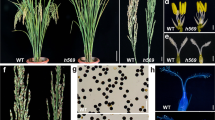Abstract
We report in this study, an improved method for identifying male sterile–restorer combinations using the barnase–barstar system of pollination control for heterosis breeding in crop plants, as an alternative to the conventional line × tester cross method. In this strategy, a transgenic male sterile barnase line was retransformed with appropriate barstar constructs. Double transformants carrying both the barnase and barstar genes were identified and screened for their male fertility status. Using this strategy, 66–90% of fertile retransformants (restored events) were obtained in Brassica juncea using two different barstar constructs. Restored events were analysed for their pollen viability and copy number of the barstar gene. Around 90% of the restored events showed high pollen viability and ∼30% contained single copy integrations of the barstar gene. These observations were significantly different from those made in our earlier studies using line (barnase) × tester (barstar) crosses, wherein only two viable male sterile–restorer combinations were identified by screening 88 different cross-combinations. The retransformation strategy not only generated several independent restorers for a given male sterile line from a single transformation experiment but also identified potential restorers in the T0 generation itself leading to significant savings in time, cost and labour. Single copy restored plants with high pollen viability were selfed to segregate male sterile (barnase) and restorer (barstar) lines in the T1 progeny which could subsequently be diversified into appropriate combiners for heterosis breeding. This strategy will be particularly useful for crop plants where poor transformation frequencies and/or lengthy transformation protocols are a major limitation.


Similar content being viewed by others
References
Bisht NC, Jagannath A, Gupta V, Burma PK, Pental D (2004) A two gene–two promoter system for enhanced expression of a restorer gene (barstar) and development of improved fertility restorer lines for hybrid seed production in crop plants. Mol Breed 14:129–144
Hajdukiewicz P, Svab Z, Maliga P (1994) The small versatile pPZP family of Agrobacterium binary vectors for plant transformation. Plant Mol Biol 25:989–994
Heslop-Harrison J, Heslop-Harrison Y, Shivanna KR (1984) The evaluation of pollen quality and a further appraisal of the fluorochromatic (FCR) test procedure. Theor Appl Genet 67:367–375
Jagannath A, Bandyopadhyay P, Arumugam N, Gupta V, Burma PK, Pental D (2001) The use of a Spacer DNA fragment insulates the tissue-specific expression of a cytotoxic gene (barnase) and allows high-frequency generation of transgenic male sterile lines in Brassica juncea L. Mol Breed 8:11–23
Jagannath A, Arumugam N, Gupta V, Pradhan AK, Burma PK, Pental D (2002) Development of transgenic barstar lines and identification of a male sterile (barnase)/restorer (barstar) combination for heterosis breeding in Indian oilseed mustard (Brassica juncea). Curr Sci 82:46–52
Jagannath A, Bandyopadhyay P, Mehra S, Arumugam N, Burma PK, Pental D (2003) Agrobacterium-mediated genetic transformation of Brassica juncea. In: Jaiwal PK, Singh RP (eds) Plant genetic engineering, vol 2. Improvement of food crops. Sci Tech Publishing LLC, USA, pp 349–360
Klimyuk VI, Carroll BJ, Thomas CM, Jones JDG (1993) Alkali treatment for rapid preparation of plant material for reliable PCR analysis. Plant J 3:493–494
Koltunow AM, Truettner J, Cox KH, Wallroth M, Goldberg RB (1990) Different temporal and spatial gene expression patterns occur during anther development. Plant Cell 2:1201–1224
Mattanovich D, Ruker F, Machado A, Laimer M, Regner F, Steinkellner H, Himmler G (1989) Efficient transformation of Agrobacterium spp. by electroporation. Nucl Acids Res 17:6747
Mariani C, De Beuckeleer M, Truettner J, Leemans J, Goldberg RB (1990) Induction of male sterility in plants by a chimeric ribonuclease gene. Nature 347:737–741
Mariani C, Gossele V, De Beuckeleer M, De Block M, Goldberg RB, De Greef W, Leemans J (1992) A chimaeric ribonuclease-inhibitor gene restores fertility to male sterile plants. Nature 357:384–387
Mehra S, Pareek A, Bandyopadhyay P, Sharma P, Burma PK, Pental D (2000) Development of transgenics in Indian oilseed mustard (Brassica juncea) resistant to herbicide phosphinothricin. Curr Sci 78:1358–1364
Paul W, Hodge R, Smartt S, Draper J, Scott R (1992) The isolation and characterization of the tapetum specific Arabidopsis thaliana A9 gene. Plant Mol Biol 19:611–622
Sambrook J, Fritsch EF, Maniatis T (1989) Molecular cloning: A laboratory manual, 2nd edn. Cold Spring Harbor Laboratory Press, Plainview, NY
Acknowledgements
This work was supported by a research grant from the National Dairy Development Board and its subsidiary Dhara Vegetable Oil and Food Company Limited (DOFCO) and the Department of Biotechnology, Government of India. N.C.B. was supported by a Research Fellowship from the Council of Scientific and Industrial Research (CSIR).
Author information
Authors and Affiliations
Corresponding author
Additional information
Communicated by W. Harwood
Rights and permissions
About this article
Cite this article
Bisht, N.C., Jagannath, A., Burma, P.K. et al. Retransformation of a male sterile barnase line with the barstar gene as an efficient alternative method to identify male sterile–restorer combinations for heterosis breeding. Plant Cell Rep 26, 727–733 (2007). https://doi.org/10.1007/s00299-006-0274-7
Received:
Revised:
Accepted:
Published:
Issue Date:
DOI: https://doi.org/10.1007/s00299-006-0274-7




